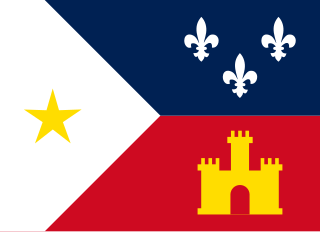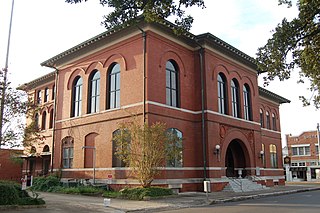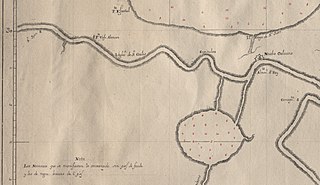
Cajun cuisine is a style of cooking developed by the Cajun–Acadians who were deported from Acadia to Louisiana during the 18th century and who incorporated West African, French and Spanish cooking techniques into their original cuisine.

The Cajuns, also known as Louisiana Acadians, are a Louisiana French ethnicity mainly found in the U.S. state of Louisiana and surrounding Gulf Coast states.

St. Martin Parish is a parish located in the U.S. state of Louisiana, founded in 1811. Its parish seat is St. Martinville, and the largest city is Breaux Bridge. At the 2020 census, the population was 51,767. St. Martin Parish is part of the Lafayette metropolitan area in the region of Acadiana, along the Gulf Coast.

St. Landry Parish is a parish located in the U.S. state of Louisiana. As of the 2020 Census, the population was 82,540. The parish seat is Opelousas. The parish was established in 1807.

Evangeline Parish is a parish located in the U.S. state of Louisiana. As of the 2020 census, the population was 32,350. The parish seat is Ville Platte.

Carencro is a city in Lafayette Parish, Louisiana, United States. It is a suburb of the nearby city of Lafayette. The population was 7,526 at the 2010 census, up from 6,120 in 2000; at the 2020 census, its population was 9,272. The name of the city is derived from the Cajun French word for buzzard; the spot where the community was settled was one where large flocks of American black vultures roosted in the bald cypress trees. The name means "carrion crow." Carencro is part of the Lafayette metropolitan area.

Opelousas is a small city and the parish seat of St. Landry Parish, Louisiana, United States. Interstate 49 and U.S. Route 190 were constructed with a junction here. According to the 2020 census, Opelousas has a population of 15,786, a 6.53 percent decline since the 2010 census, which had recorded a population of 16,634. Opelousas is the principal city for the Opelousas-Eunice Micropolitan Statistical Area, which had an estimated population of 80,808 in 2020. Opelousas is also the fourth largest city in the Lafayette-Acadiana Combined Statistical Area, which has a population of 537,947.

Breaux Bridge is a small city in St. Martin Parish, Louisiana, United States. The population was 8,139 as of the 2010 census, up from 7,281 in 2000. By 2020, its population was 7,513. It is part of the Lafayette metropolitan statistical area.

St. Martinville is a city in and the parish seat of St. Martin Parish, Louisiana, United States. It lies on Bayou Teche, 13 miles (21 km) south of Breaux Bridge, 16 miles (26 km) southeast of Lafayette, and 9 miles (14 km) north of New Iberia. The population was 6,114 at the 2010 U.S. census, and 5,379 at the 2020 United States census. It is part of the Lafayette metropolitan statistical area.

Acadiana, also known as the Cajun Country, is the official name given to the French Louisiana region that has historically contained much of the state's Francophone population.

Brigadier-General Charles Lawrence was a British military officer who, as lieutenant governor and subsequently governor of Nova Scotia, is perhaps best known for overseeing the Expulsion of the Acadians and settling the New England Planters in Nova Scotia. He was born in Plymouth, England, and died in Halifax, Nova Scotia. According to historian Elizabeth Griffiths, Lawrence was seen as a "competent", "efficient" officer with a "service record that had earned him fairly rapid promotion, a person of considerable administrative talent who was trusted by both Cornwallis and Hopson." He is buried in the crypt of St. Paul's Church (Halifax).

Louisiana Creoles are a Louisiana French ethnic group descended from the inhabitants of colonial Louisiana before it became a part of the United States during the period of both French and Spanish rule. They share cultural ties such as the traditional use of the French, Spanish, and Creole languages and predominant practice of Catholicism.
Joseph Broussard (1702–1765), also known as Beausoleil, was a leader of the Acadian people in Acadia; later Nova Scotia, Prince Edward Island, and New Brunswick. Broussard organized Mi'kmaq and Acadian militias against the British through King George's War, Father Le Loutre's War and during the Seven Years' War. After Acadia was captured by the British, he eventually led the first group of Acadians to southern Louisiana in the present-day United States. His name is sometimes presented as Joseph Gaurhept Broussard; this is likely the result of a transcription error. Broussard is widely regarded as a hero and an important historical figure by both Acadians and Cajuns.

The German Coast was a region of early Louisiana settlement located above New Orleans, and on the west bank of the Mississippi River. Specifically, from east to west, in St. Charles, St. John the Baptist, and St. James parishes of present-day Acadiana. It was largely settled by German immigrants and their African slaves. The four settlements of Augsburg, Hoffen, Karlstein, and Marienthal were located along this "coast".
Carl Anthony Brasseaux is an American historian and educator. He specialized in French Colonial North America, particularly of Louisiana and the Cajun people. He helped to pioneer the field of Cajun history, and his published works on this topic represent the first serious, in-depth examination of the history of the ethnic group.

Glenn Russell Conrad was an American historian, professor, and author. He is known for his research of south Louisiana culture, as well as an expert on archival studies, nineteenth-century European history, and the history of colonial Louisiana. He taught at Southern Colorado State and the University of Southwestern Louisiana from 1958 until 1991, and serving as the director of the Center of Louisiana Studies at University of Southern Louisiana from 1973 until 1993.

Lafayette, Louisiana, and the surrounding area is a mix of American Indian, African American, English, French and Spanish culture. The area is situated in the region known as South Central Louisiana. The Vermilion River runs through the city. Today, the city and parish are at the heart of Acadiana.

Charles-Philippe Aubry or Aubri was a French soldier and colonial administrator, who served as governor of Louisiana twice in the 18th century.

Vermilionville Historic Village, located in Lafayette, Louisiana, is a Cajun and Creole living history museum with a combination of restored and replica historic structures.

















